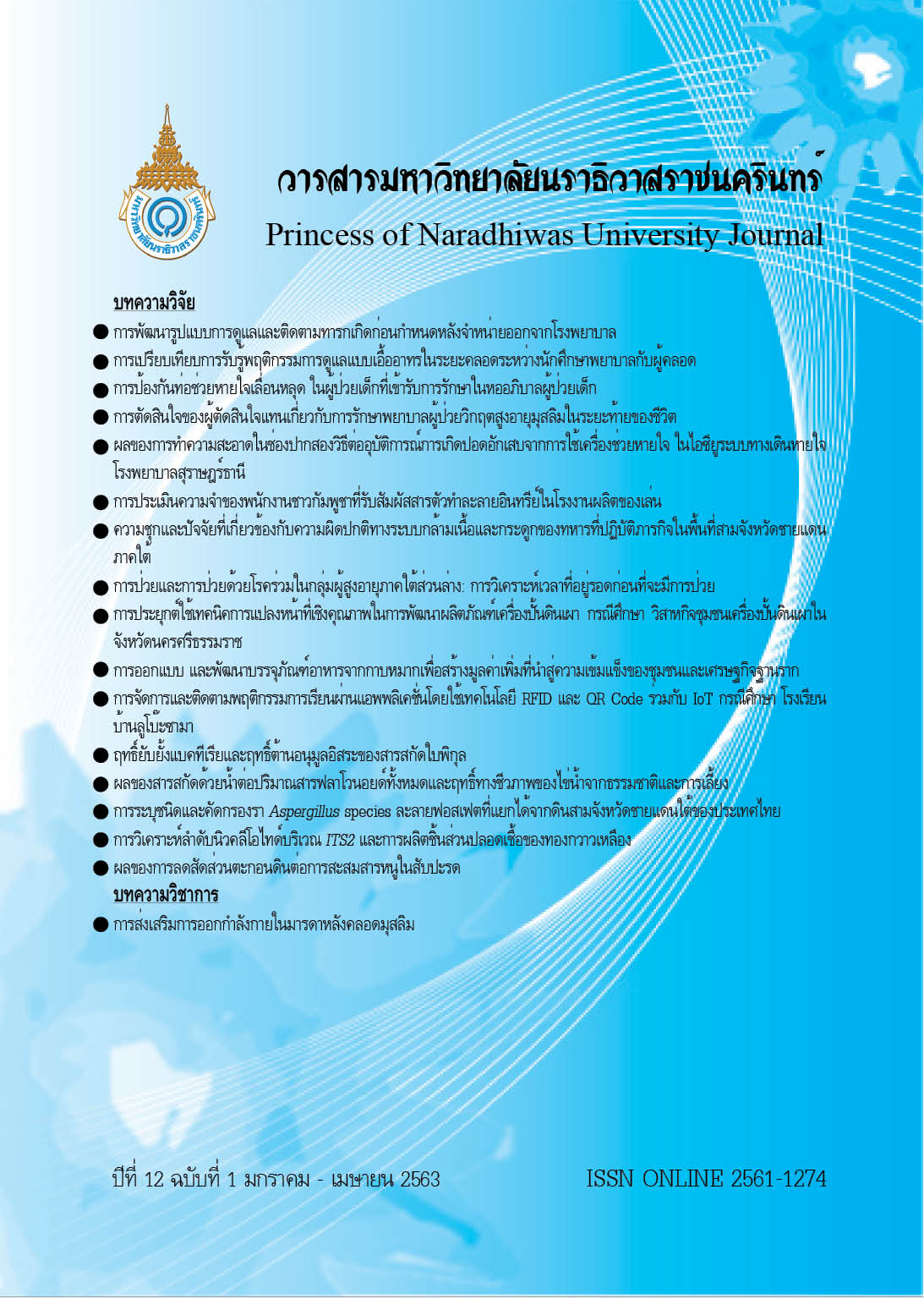ITS2 Nucleotide Sequence Analysis and Cleaned Culture Production of Butea monosperma var. lutea
Keywords:
Butea Monosperma, Micropropagation, Biocide, Native Plant, DNA BarcodingAbstract
Yellow Flame of the Forest (Butea monosperma (Lam.) Kuntze var. lutea (Witt.) Maheswari) is a rare ornamental and medicinal plant used for the treatment of vaginal discharge, skin diseases, and as an
antidiarrheal. Thus, the discrimination between yellow and orange varieties is important, so DNA barcoding
technique using specific primers for matK, ITS2 and rbcL regions were performed. As a result, it was found
that only ITS2 region could be amplified (66.67%). The BlanstN DNA analysis also showed that ITS sequences
had high homology (99%) to B. monosperma (AC: KJ436383). However, the multiple sequence alignment of
these amplified fragments showed no difference between the yellow and orange varieties. Thus, additional
markers should be developed for more effective discrimination. Of these, the ITS2 sequences have already
been deposited in the NCBI database (AC: MK651821, MK651822, MK651823, and MK651824). Because the plant has a high risk of extinction, micropropagation is an effective method to increase its quantity and maintain these rare species. However, the surface of this plant is covered with dense hairs, which makes surface sterilization difficult. Therefore, surface sterilization techniques, with the addition of several
disinfectants, into various culture media, were investigated. The lowest contamination (30.0%) with 72.4%
of survivability was achieved by adding 400 µl/l Plant Preservatives Mixture (PPM) in MS media. The use
of 400 µl/l PPM, in combination with BA 2 or 4 mg/l to stimulate growth of lateral bud, showed a lower
survival percentage than the control treatment (25-58.3%). For the addition of various microbial disinfectant
agents in liquid WPM (Woody Plant Media), the lowest contamination (22.2%) was obtained from liquid
WPM containing 400 µl/l PPM in combination with 250 mg/l streptomycin or 250 mg/l carbendazim.
The highest surviving rate (90.8%) was observed in the media supplement with PPM and streptomy
References
Bhadane, B. S., & Patil, R. H. (2016). Data on the cost effective surface sterilization method for C. carandas (L.) seeds and callus induction from aseptic seedling. Data in brief, 7, 1551.
Cowan, R. S., & Fay, M. F. (2012). Challenges in the DNA barcoding of plant material. In Plant DNA Fingerprinting and Barcoding (pp. 23-33): Springer.
Doyle J.J. & J.L. Doyle. (1987). A rapid DNA isolation procedure for small quantities of fresh leaf tissue. Phytochemical bulletin, 19, 11–15.
Fazekas, A. J., Kuzmina, M. L., Newmaster, S. G., & Hollingsworth, P. M. (2012). DNA barcoding methods for land plants. In Methods in Molecular Biology, 858, 223-252.
Gunakkunru, A., Padmanaban, K., Thirumal, P., Pritila, J., Parimala, G., Vengatesan, N., Pillai, K. K. (2005). Anti-diarrhoeal activity of Butea monosperma in experimental animals. Journal of Ethnopharmacology,98(3), 241-244.
Han, Y.-W., Duan, D., Ma, X.-F., Jia, Y., Liu, Z.-L., Zhao, G.-F., & Li, Z.-H. (2016). Efficient identification of the forest tree species in Aceraceae using DNA barcodes. Frontiers in plant science, 7, 1707.
Kaewsri, W. (2014). Native plant genetic of Amnathcharoen Provice. Amnathcharoen: Pimdee Amnathcharoen Offset. (in Thai)
Kanjanawattanawong, S., Tangphatsornruang, S., Triwitayakorn, K., Ruang-areerate, P., Sangsrakru, D., Poopear, S., . . . Narangajavana, J. (2014). Characterization of rubber tree microRNA in phytohormone response using large genomic DNA libraries, promoter sequence and gene expression analysis. Molecular genetics and genomics, 289(5), 921-933.
Kumar, S., Stecher, G., & Tamura, K. (2016). MEGA7: molecular evolutionary genetics analysis version 7.0 for bigger datasets. Molecular biology and evolution, 33(7), 1870-1874.
Liu, Z.-F., Ci, X.-Q., Li, L., Li, H.-W., Conran, J. G., & Li, J. (2017). DNA barcoding evaluation and implicationsfor phylogenetic relationships in Lauraceae from China. Retrieved from https:// journals.plos.org/plosone/article?id=10.1371/journal.pone.0175788
Mahender, A., Mahesh, D. M., & Murthy, E. N. (2014). In vitro seed germination and development of Butea monosperma (Lam.) Taub Var. lutea (Willt.): a step for rehabilitation. International Journal of Multidisciplinary and Current Research, 2, 297-301.
Muhamad, S. N. S., Ling, A. P. K., & Wong, C. L. (2018). Effect of plant growth regulators on direct regeneration and callus induction from Sargassum polycystum C. Agardh. Journal of applied phycology, 30(6), 3299-3310.
Murashige, T., & Skoog, F. (1962). A revised medium for rapid growth and bio assays with tobacco tissue cultures. Physiologia Plantarum, 15(3), 473-497.
Newmaster, S. G., Grguric, M., Shanmughanandhan, D., Ramalingam, S., & Ragupathy, S. (2013). DNA barcoding detects contamination and substitution in North American herbal products. BMC Medicine, 11(1).
Panchy, N., Lehti-Shiu, M., & Shiu, S.-H. (2016). Evolution of gene duplication in plants. Plant physiology,171(4), 2294-2316.
Parveen, I., Gafner, S., Techen, N., Murch, S. J., & Khan, I. A. (2016). DNA barcoding for the identification of botanicals in herbal medicine and dietary supplements: strengths and limitations. Planta Medica,82(14), 1225-1235.
Pearson, W. R. (2013). An introduction to sequence similarity (“homology”) searching. Current protocols in bioinformatics, 42(1), 311-318.
Plant Cell Technologies. (2019). PPM™—Plant Preservative Mixture Product Information. Retrieved from https://www.plantcelltechnology.com/ppm-product-information/
Rathnaprabha, D., Muralikrishna, N., Raghu, E., & Sadanandam, A. (2017). Micropropagation of White Palash tree (Butea monosperma (Lam.) Taub. var. lutea (Witt.)). Journal of Phytology, 9(1). doi:https://doi.org/10.19071/jp.2016.v8.3070.
Rawal, K., & Keharia, H. (2019). Prevention of Fungal Contamination in Plant Tissue Culture Using Cyclic Lipopeptides Secreted by Bacillus amyloliquefaciens AB30a. Plant Tissue Culture and Biotechnology,29(1), 111-119.
Silveira, S. S., Cordeiro-Silva, R., Degenhardt-Goldbach, J., & Quoirin, M. (2016). Micropropagation of Calophyllum brasiliense (Cambess.) from nodal segments. Brazilian Journal of Biology, 76(3), 656-663.
Stevens, M. E., & Pijut, P. M. (2018). Rapid in vitro shoot multiplication of the recalcitrant species Juglans nigra L. In Vitro Cellular & Developmental Biology-Plant, 54(3), 309-317.
Thorat, A. S., Sonone, N. A., Choudhari, V. V., Devarumath, R. M., & Babu, K. H. (2017). Plant regeneration from cell suspension culture in Saccharum officinarum L. and ascertaining of genetic fidelity through RAPD and ISSR markers. 3 Biotech, 7(1), 16.
Yarra, R., Bulle, M., Mushke, R., & Murthy, E. N. (2016). In vitro conservation and genetic homogeneity assessment of Butea monosperma (Lam.) Taub. Var. lutea (Witt.) Maheshwari—A potential pharmaceutical legume tree. Journal of Applied Research on Medicinal and Aromatic Plants, 3(4), 195-199.




